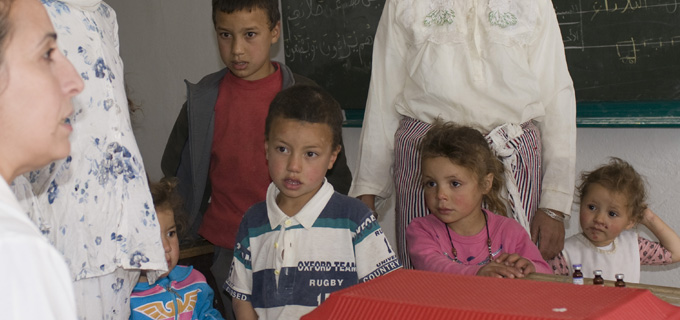Two Studies Report New Findings on Respiratory Diseases in Morocco
Spanish and Moroccan researchers study the causes, epidemiology and prognostic factors of severe pneumonia in children
03.11.2014
There is very little epidemiological, clinical and microbiological data available on respiratory tract infections in children in Morocco. The publication of two new studies on severe pneumonia in this country is therefore of particular interest. ISGlobal researcher Quique Bassat led both studies, which looked at 700 children under five years of age who were admitted to Rabat's children's hospital with clinically severe pneumonia.
A study published in the International Journal of Infectious Diseases investigated the factors associated with poor prognosis in children younger than five years of age with clinically severe pneumonia. One quarter of the nearly 700 children analysed in the study developed complications and required prolonged hospitalisation and intensive care; in some cases these resulted in death. The risk factors independently associated with a poor prognosis included a history of prematurity, fever prior to hospitalisation, living with smokers, cyanosis, pallor, impaired consciousness at the time of hospitalisation, rhonchi on auscultation, and human metapneumovirus infection. The researchers concluded that identifying the factors associated with a poor prognosis at an early stage could improve treatment strategies and increase the likelihood of survival in Moroccan children with severe pneumonia.
Another study, which was published in the Journal of Tropical Pediatrics, has described the aetiology and epidemiology of respiratory distress in children under five years of age. The most frequent clinical diagnoses were wheezing-related conditions (bronchitis, asthma and bronchiolitis), whereas typical bacterial pneumonia was less frequent. While invasive bacterial disease detected by classical microbiology or molecular methods was also uncommon, respiratory viruses in the nasopharynx were detected in almost all cases. The three most frequently detected viruses were rhinovirus (53%), respiratory syncytial virus (18%) and adenovirus (17%). The authors concluded that the epidemiological profile of acute respiratory infections in children in Morocco is similar to that of high-income countries. However, the high mortality rate associated with pneumonia indicates that preventive and clinical management strategies need to be improved.
"This information is very important because, surprisingly, there was previously no complete description of the aetiology, epidemiology and risk factors associated with a poor prognosis in Moroccan children with severe pneumonia," explains Quique Bassat, the coordinator of both studies. "These findings will presumably help the Moroccan Ministry of Health to improve the prevention and management of infections that still cause an unacceptable number of deaths."
More information:
Jroundi I, Mahraoui C, Benmessaoud R, Moraleda C, Tligui H, Seffar M, Kettani SE, Benjelloun BS, Chaacho S, Muñoz-Almagro C, Ruiz J, Alonso PL, Bassat Q. Risk factors for a poor outcome among children admitted with clinically severe pneumonia to a university hospital in Rabat, Morocco. Int J Infect Dis. 2014 Oct 8
Jroundi I, Mahraoui C, Benmessaoud R, Moraleda C, Tligui H, Seffar M, Kettani SC, Benjelloun BS, Chaacho S, Maaroufi A, Hayes EB, Álvarez-Martínez MJ, Muñoz-Almagro C, Ruiz J, Alonso PL, Bassat Q. The epidemiology and aetiology of infections in children admitted with clinical severe pneumonia to a university hospital in Rabat, Morocco. J Trop Pediatr. 2014 Feb 25.



